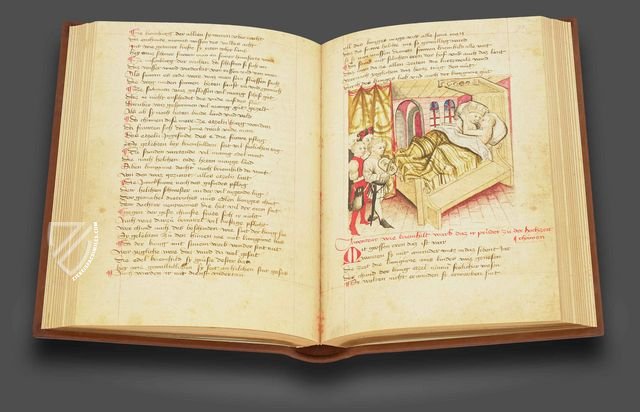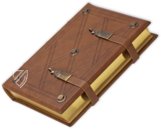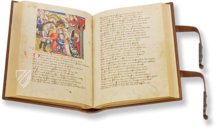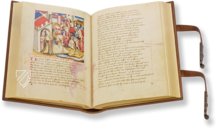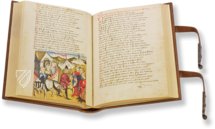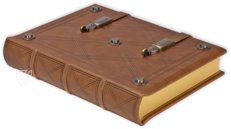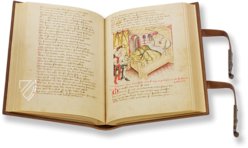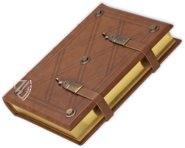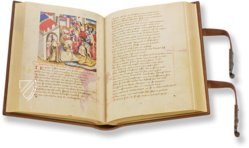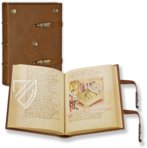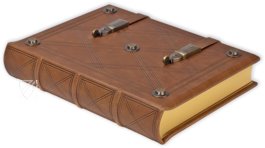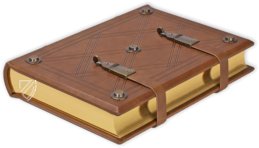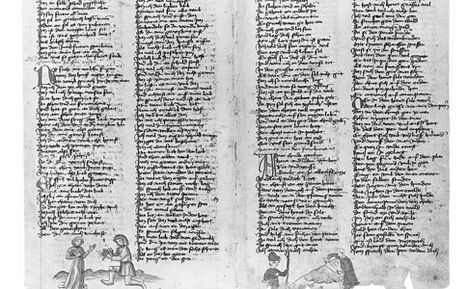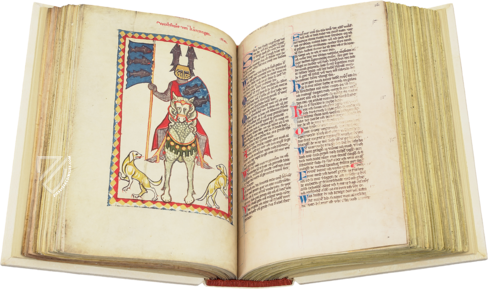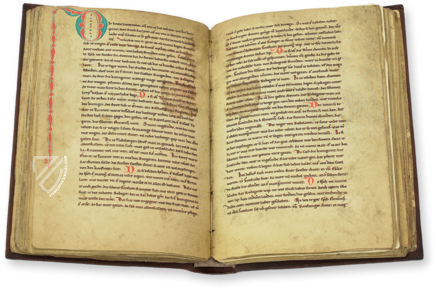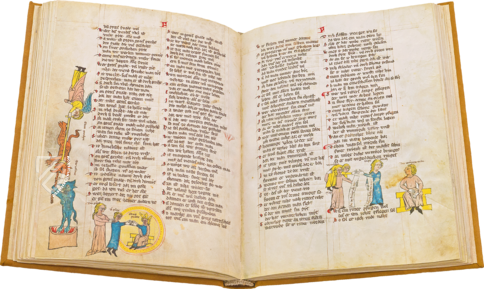Nibelungenlied
(1,000€ - 3,000€)
The Hundeshagen Codex is the sole surviving illuminated manuscript of the Song of the Nibelungs and depicts the heroic epic first written ca. 1200 with a comprehensive image cycle. Named after Helfrich Bernhard Hundeshagen, the librarian who first acquired it in 1816 shortly after it was rediscovered, the manuscript is dated to ca. 1440 and is written in the East Swabian dialect. Its 37 pen and ink illustrations still have the power to delight and animate the national epic of the Germans to this day. The famous tale of heroism, intrigue, and betrayal has its roots in historic figures and events from the 5th and 6th centuries, but the masterful miniatures of this manuscript also give a vivid image of life among the German nobility in the first half of the 15th century. We are truly lucky that this unicum has not only survived in a complete state, but both its text and miniatures are obviously the work of very practiced hands.
Nibelungenlied
The saga of Siegfried the dragon slayer was considered to be the German national epic in the 19th century. Only a single illuminated manuscript exists in Middle High German, namely the Hundeshagen Manuscript from ca. 1440. The heroic epic tells the story of Siegfried, who helps the Burgundian King Gunther return a wife home and as a reward is allowed to take the beautiful Kriemheld to wife. However his triumph does not last long, treason and intrigue lead to Siegfried’s death and endless calamities. The Hundeshagen Codex contains 384 pages with a total of 37 impressive pen and ink drawings that bring the well-known events to life.
A History Full of Open Questions
Whether or not this illuminated manuscript of the Nibelung Saga from the 15th century was the product of a commission has never been made certain. An author has been similarly sought in vain. Furthermore, nothing more can be said from which of the few previous transcripts still in existence the original version of the epic was based on. What is certain is that around 1200, elements of various Norse myths and real events of the migration period and the reign of the Merovingians were combined with one another to record the manuscript for the Huneshagen Codex, and out of it a massive heroic epic was created in Middle High German.
A German National Epic?
The Song of the Nibelungsfirst reached great fame centuries after its creation. In the Middle Ages the story made little impression next to masterworks such as Geoffrey Chaucer’s Canterbury Tales or the Divine Comedy of Dante. In the 18th and 19th centuries, the time of emerging German philology and national consciousness, researchers of the time discovered the historical worth of the text and turned it into a quintessential piece of German literature.
In Many Respects an Unusual Edition
A unique detail of the Hundeshagen Codex is the nexus of two plotlines that was undertaken. There are two different versions of the epic. In the first version the story ends with the words “that is the song of the Nibelung” and in the second version with “that is the misery of the Nibelung”. The work of the Hundeshagen edition combines the versions. The codex originates from around 1440 and was named after its owner, the librarian Helfrich Bernhard Hundeshagen. He allegedly acquired the work in 1816 from an antiquarian in Mainz, he disclosed little more about his purchase.
Unique Illustrations
The decoration of the book is as excellent as its history is mysterious: 37 magnificent book paintings in the late medieval style, which are still splendid to this day decorate the script and constitute a comprehensive pictorial cycle in their own right. A talented miniature painter executed the pen and ink drawings with assured strokes and a loving attention to detail. He used no gold decoration for his pictures, but he was successful in delighting with a great variety of colors. Fascinating depictions of knightly and courtly festivals, tournaments, hunts, intimate glimpses of the royal bedchamber, and paintings of travelling companies on water and land take the beholder to the long bygone time of the Nibelungs.
Codicology
- Alternative Titles
- Hundeshagen Codex
Hundeshagener Codex
Berlin Nibelungenlied - Type
- Manuscript on paper
- Size / Format
- 384 pages / 28.2 × 20.5 cm
- Origin
- Germany
- Date
- 15th century
- Epochs
- Style
- Genre
- Language
- Script
- Littera bastarda
- Illustrations
- 37 magnificent pen-and-ink drawings
- Content
- Nibelungenlied und Klage
- Previous Owners
- Helfrich Bernhard Hundeshagen (1784–1858)
Nibelungenlied
Siegfried as a Messenger in Worms
After conquering the kingdom of Nibelungenland, Siegfried leads one thousand of his new vassals back to Worms, a central setting in the heroic epic, in addition to his party of Burgundians, King Gunther, and Queen Brünhild of Iceland. He rides ahead of this host to deliver news of his success and the arrival of his party. Having crossed the drawbridge into the city over what is likely intended to be the Upper Rhine, Siegfried is shown in a blue hood handing over a message with two seals.

Nibelungenlied
Kriemhild's Dream of the Falcon
This is the only surviving comprehensive picture cycle of the German national epic. In one of the first scenes, Kriemhild has a prophetic dream in which she sees a falcon killed by two eagles, portending the death of her future husband, Siegfried. Kriemhild's mother Ute is pictured standing at the foot of the bed.
The scene is framed by a Gothic doorway and is filled with details of a 15th century noblewoman’s bedchamber, including a bedpan. Ute wears the flowing robes typical for a contemporary German noblewoman, while Kriemhild sleeps in the nude, which was also typical. Another doorway leads into a room with a red/green column, creating a wonderful sense of perspective and spatiality within this deeply intimate room.
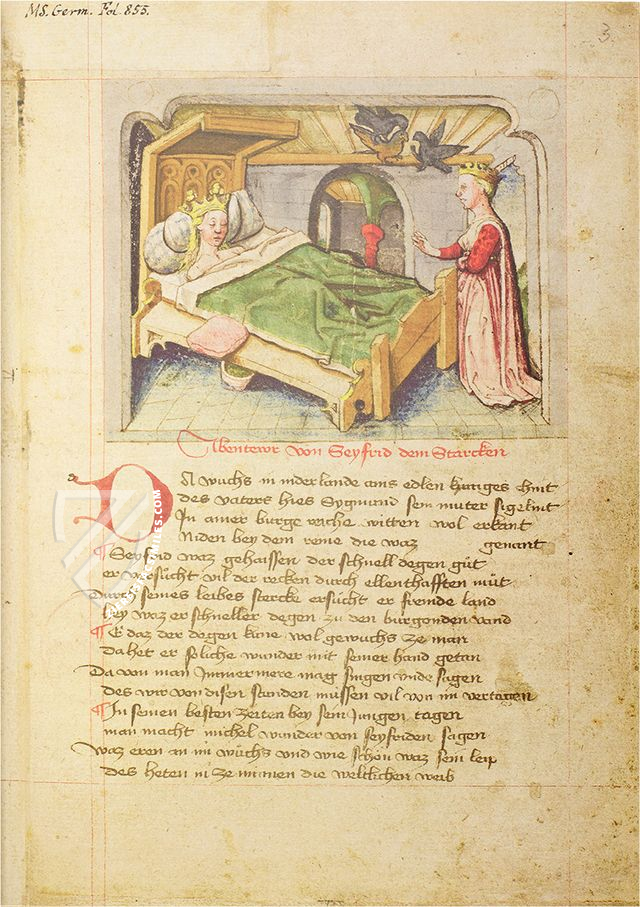
#1 Nibelungenlied
Language: German
(1,000€ - 3,000€)
- Treatises / Secular Books
- Apocalypses / Beatus
- Astronomy / Astrology
- Bestiaries
- Bibles / Gospels
- Chronicles / History / Law
- Geography / Maps
- Saints' Lives
- Islam / Oriental
- Judaism / Hebrew
- Single Leaf Collections
- Leonardo da Vinci
- Literature / Poetry
- Liturgical Manuscripts
- Medicine / Botany / Alchemy
- Music
- Mythology / Prophecies
- Psalters
- Other Religious Books
- Games / Hunting
- Private Devotion Books
- Other Genres
- Afghanistan
- Armenia
- Austria
- Belgium
- Belize
- Bosnia and Herzegovina
- China
- Colombia
- Costa Rica
- Croatia
- Cyprus
- Czech Republic
- Denmark
- Egypt
- El Salvador
- Ethiopia
- France
- Germany
- Greece
- Guatemala
- Honduras
- Hungary
- India
- Iran
- Iraq
- Israel
- Italy
- Japan
- Jordan
- Kazakhstan
- Kyrgyzstan
- Lebanon
- Liechtenstein
- Luxembourg
- Mexico
- Morocco
- Netherlands
- Palestine
- Panama
- Peru
- Poland
- Portugal
- Romania
- Russia
- Serbia
- Spain
- Sri Lanka
- Sweden
- Switzerland
- Syria
- Tajikistan
- Turkey
- Turkmenistan
- Ukraine
- United Kingdom
- United States
- Uzbekistan
- Vatican City
- A. Oosthoek, van Holkema & Warendorf
- Aboca Museum
- Ajuntament de Valencia
- Akademie Verlag
- Akademische Druck- u. Verlagsanstalt (ADEVA)
- Aldo Ausilio Editore - Bottega d’Erasmo
- Alecto Historical Editions
- Alkuin Verlag
- Almqvist & Wiksell
- Amilcare Pizzi
- Andreas & Andreas Verlagsbuchhandlung
- Archa 90
- Archiv Verlag
- Archivi Edizioni
- Arnold Verlag
- ARS
- Ars Magna
- ArtCodex
- AyN Ediciones
- Azimuth Editions
- Badenia Verlag
- Bärenreiter-Verlag
- Belser Verlag
- Belser Verlag / WK Wertkontor
- Benziger Verlag
- Bernardinum Wydawnictwo
- BiblioGemma
- Biblioteca Apostolica Vaticana (Vaticanstadt, Vaticanstadt)
- Bibliotheca Palatina Faksimile Verlag
- Bibliotheca Rara
- Boydell & Brewer
- Bramante Edizioni
- Bredius Genootschap
- Brepols Publishers
- British Library
- C. Weckesser
- Caixa Catalunya
- Canesi
- CAPSA, Ars Scriptoria
- Caratzas Brothers, Publishers
- Carus Verlag
- Casamassima Libri
- Centrum Cartographie Verlag GmbH
- Chavane Verlag
- Christian Brandstätter Verlag
- Circulo Cientifico
- Club Bibliófilo Versol
- Club du Livre
- CM Editores
- Collegium Graphicum
- Collezione Apocrifa Da Vinci
- Comissão Nacional para as Comemorações dos Descobrimentos Portugueses
- Coron Verlag
- Corvina
- CTHS
- D. S. Brewer
- Damon
- De Agostini/UTET
- De Nederlandsche Boekhandel
- De Schutter
- Deuschle & Stemmle
- Deutscher Verlag für Kunstwissenschaft
- DIAMM
- Droz
- E. Schreiber Graphische Kunstanstalten
- Ediciones Boreal
- Ediciones Grial
- Ediclube
- Edições Inapa
- Edilan
- Editalia
- Edition Deuschle
- Edition Georg Popp
- Edition Leipzig
- Edition Libri Illustri
- Editiones Reales Sitios S. L.
- Éditions de l'Oiseau Lyre
- Editions Medicina Rara
- Editorial Casariego
- Editorial Mintzoa
- Editrice Antenore
- Editrice Velar
- Edizioni Edison
- Egeria, S.L.
- Eikon Editores
- Electa
- Emery Walker Limited
- Enciclopèdia Catalana
- Eos-Verlag
- Ephesus Publishing
- Ernst Battenberg
- Eugrammia Press
- Extraordinary Editions
- Fackelverlag
- Facsimila Art & Edition
- Facsimile Editions Ltd.
- Facsimilia Art & Edition Ebert KG
- Faksimile Verlag
- Feuermann Verlag
- Folger Shakespeare Library
- Franco Cosimo Panini Editore
- Friedrich Wittig Verlag
- Fundación Hullera Vasco-Leonesa
- G. Braziller
- Gabriele Mazzotta Editore
- Gebr. Mann Verlag
- Gesellschaft für graphische Industrie
- Getty Research Institute
- Giovanni Domenico de Rossi
- Giunti Editore
- Graffiti
- Grafica European Center of Fine Arts
- Guido Pressler
- Guillermo Blazquez
- Gustav Kiepenheuer
- H. N. Abrams
- Harrassowitz
- Harvard University Press
- Helikon
- Hendrickson Publishers
- Henning Oppermann
- Herder Verlag
- Hes & De Graaf Publishers
- Hoepli
- Holbein-Verlag
- Houghton Library
- Hugo Schmidt Verlag
- Idion Verlag
- Il Bulino, edizioni d'arte
- ILte
- Imago
- Insel Verlag
- Insel-Verlag Anton Kippenberger
- Instituto de Estudios Altoaragoneses
- Instituto Nacional de Antropología e Historia
- Introligatornia Budnik Jerzy
- Istituto dell'Enciclopedia Italiana - Treccani
- Istituto Ellenico di Studi Bizantini e Postbizantini
- Istituto Geografico De Agostini
- Istituto Poligrafico e Zecca dello Stato
- Italarte Art Establishments
- Jan Thorbecke Verlag
- Johnson Reprint Corporation
- Josef Stocker
- Josef Stocker-Schmid
- Jugoslavija
- Karl W. Hiersemann
- Kasper Straube
- Kaydeda Ediciones
- Kindler Verlag / Coron Verlag
- Kodansha International Ltd.
- Konrad Kölbl Verlag
- Kurt Wolff Verlag
- La Liberia dello Stato
- La Linea Editrice
- La Meta Editore
- Lambert Schneider
- Landeskreditbank Baden-Württemberg
- Leo S. Olschki
- Les Incunables
- Liber Artis
- Library of Congress
- Libreria Musicale Italiana
- Lichtdruck
- Lito Immagine Editore
- Lumen Artis
- Lund Humphries
- M. Moleiro Editor
- Maison des Sciences de l'homme et de la société de Poitiers
- Manuscriptum
- Martinus Nijhoff
- Maruzen-Yushodo Co. Ltd.
- MASA
- Massada Publishers
- McGraw-Hill
- Metropolitan Museum of Art
- Militos
- Millennium Liber
- Müller & Schindler
- Nahar - Stavit
- Nahar and Steimatzky
- National Library of Wales
- Neri Pozza
- Nova Charta
- Oceanum Verlag
- Odeon
- Orbis Mediaevalis
- Orbis Pictus
- Österreichische Staatsdruckerei
- Oxford University Press
- Pageant Books
- Parzellers Buchverlag
- Patrimonio Ediciones
- Pattloch Verlag
- PIAF
- Pieper Verlag
- Plon-Nourrit et cie
- Poligrafiche Bolis
- Presses Universitaires de Strasbourg
- Prestel Verlag
- Princeton University Press
- Prisma Verlag
- Priuli & Verlucca, editori
- Pro Sport Verlag
- Propyläen Verlag
- Pytheas Books
- Quaternio Verlag Luzern
- Reales Sitios
- Recht-Verlag
- Reichert Verlag
- Reichsdruckerei
- Reprint Verlag
- Riehn & Reusch
- Roberto Vattori Editore
- Rosenkilde and Bagger
- Roxburghe Club
- Salerno Editrice
- Saltellus Press
- Sandoz
- Sarajevo Svjetlost
- Schöck ArtPrint Kft.
- Schulsinger Brothers
- Scolar Press
- Scrinium
- Scripta Maneant
- Scriptorium
- Shazar
- Siloé, arte y bibliofilia
- SISMEL - Edizioni del Galluzzo
- Sociedad Mexicana de Antropología
- Société des Bibliophiles & Iconophiles de Belgique
- Soncin Publishing
- Sorli Ediciones
- Stainer and Bell
- Studer
- Styria Verlag
- Sumptibus Pragopress
- Szegedi Tudomànyegyetem
- Taberna Libraria
- Tarshish Books
- Taschen
- Tempus Libri
- Testimonio Compañía Editorial
- Thames and Hudson
- The Clear Vue Publishing Partnership Limited
- The Facsimile Codex
- The Folio Society
- The Marquess of Normanby
- The Richard III and Yorkist History Trust
- Tip.Le.Co
- TouchArt
- TREC Publishing House
- TRI Publishing Co.
- Trident Editore
- Tuliba Collection
- Typis Regiae Officinae Polygraphicae
- Union Verlag Berlin
- Universidad de Granada
- University of California Press
- University of Chicago Press
- Urs Graf
- Vallecchi
- Van Wijnen
- VCH, Acta Humaniora
- VDI Verlag
- VEB Deutscher Verlag für Musik
- Verlag Anton Pustet / Andreas Verlag
- Verlag Bibliophile Drucke Josef Stocker
- Verlag der Münchner Drucke
- Verlag für Regionalgeschichte
- Verlag Styria
- Vicent Garcia Editores
- W. Turnowski Ltd.
- W. Turnowsky
- Waanders Printers
- Wiener Mechitharisten-Congregation (Wien, Österreich)
- Wissenschaftliche Buchgesellschaft
- Wissenschaftliche Verlagsgesellschaft
- Wydawnictwo Dolnoslaskie
- Xuntanza Editorial
- Zakład Narodowy
- Zollikofer AG

